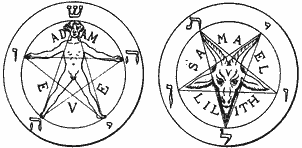
BAPHOMET - the Sigil of Baphomet
Guardians of Darkness
RC Priest and Tani Jantsang (from longer article).
Here you will find the most extensive information on the Baphomet - what it means and what it does not mean.
First, let's clear the air and state that this was never a symbol of the Devil or Satan or of anything evil or bad. It only became associated with that after Anton Lavey saw it in a book filled with errors, liked it and decided to "make it" into a symbol for his cult. Therefore, what you read here will not be anything related to the modern "satanic" use of this symbol by various "satanic" groups. The use of this esoteric symbol by modern satanic cults is, in our opinion, as sad as the use of the Swastika by the Nazis. No one can use either symbol today without either being ridiculed or physically harmed. All of that can be blamed on the misuse of these symbols by ignorant people.
The Baphomet is also associated with the Androgyne Goat of Mendes. Only in the (ignorant) literature of the Inquisition, was the Biblical satan turned into Pan and associated with Witchcraft.
Eliphas Levi, who drew the full figured Goat of Mendes, translated "Baphomet" as a reversed composition of three abbreviations: Tem. Oph. Ab., standing for the Latin Templi omnium hominum pacis abhas: "(The God of) the Temple of Peace Among All Men." Levi felt this to be a reference to King Solomon's Temple, which he believed had the sole purpose of bringing peace to the world.
Eliphas Levi considered the Baphomet to be a depiction of the Absolute in symbolic form and, as such, this is fully explained in the article Sigil of Baphomet sold here. According to the author Michael Howard, Levi based the illustration of his Baphomet on a Gargoyle that was on a building: the Commandry of Saint Bris le Vineux, owned by the Knights Templars. He says:
"The Gargoyle is in the form of a bearded horned figure with pendulous female breasts, wings and cloven feet. It sits in a crossed-legged position which resembles statues of the Celtic stag god, Cernnunnus or the Horned One, found in Gaul (France) before the Roman occupation."
Furthermore, Eliphas Levi, was the first person to adapt the 2 points up pentagram as symbolic of evil. He was incorrect. He invented that concept on his own.
In the Middle Ages the one point up pentagram represented summer, while the two points up pentagram was a representation of winter. [Note that the Eastern Star of Freemasonry still uses the star with 2 points up and they certainly do not consider it upside down or inverted or evil.) This 2-pointed up pentacle is the true Pythagorean Pentacle, which was considered a PENTAGONAS - meaning 5 angles. The PENTAGON in the center was a house; as such it is correct with 2 points up - and has nothing to do with the seasons.
Levi formed two illustrations of the pentagram the first, his "good" orientation, featured the five points of a man within the points of the Pentagram, the names Adam and Eve are in the star and Yshua in Hebrew letters are around it. This is called the microcosmic man and represents the four elements, earth, wind, fire and water represented as the man's limbs with his head representing the spirit (see Sigil of Baphomet for a fuller explanation without the Christian or other bias).
Next to the Microcosmic Man, shown in his 1 point up star, Levi drew the 2 point up pentagram with the goat's head or Baphomet head in it. Samael and Lilith are written in the star, with the word Leviathan around it. In so doing, he formed, for the first time, a differentiation between good and evil symbolized by the pentagram.
The illustration below shows Levi's two sketches.

Also is an image of the Devil from the Marseilles Tarot (below, left). and the Devil from The Waite-Rider Tarot, 1909 (below, right)
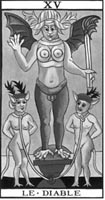 |
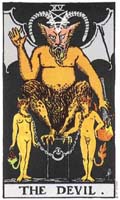 |
Also shown here is a Narjolpa from Magic and Mystery in Tibet by Alexandra David Neel. Note he is seated in same the same position, with the arms in the same position, as the Mendesian Goat.
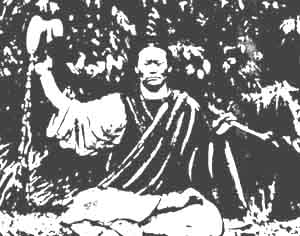 |
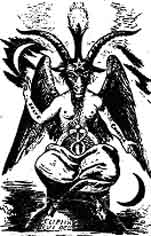 |
Also in Esoteric Tradition: Eagle, double headed Eagle: TEM OF AB ("ph" is the "F" sound) meaning Duplex Avis Generation: spelled backwards the word is Baphomet/Bafomet.
Also, from the Egyptian mystery portions: Tem: to name as in to proclaim: Tem is a title of Apep. Oph (again, the "ph" is an "F" sound as in "foe"): winged serpent or dragon. Ab hearing, wisdom, and understanding; intelligence and Will. Again, Baphomet (Bafomet) spelled backwards. In short: Serpent of Wisdom, Serpent Knowledge. The Narjolpa is doing a yoga connected to Kundalini Yoga; Kundalini means Inner Serpent.
The word Baphomet is semi-Greek: Baphe Metis. It means initiation by origin of water (baptismo) and Wisdom of Measurement as by math (metes - metric). In esoteric literature there is shown the far more ancient Babylonian version of the word: Bahu Mid. Unfortunately, this is not easy to come by. Bahu is Hebrew for The Waters (not the ocean). Elohim (God) moved over the face of Bahu (the waters). Here is the image of the Baphomet with the word "Baphomet" around the image:
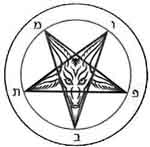
The Knights Templar, whatever else they may have been, were Roman Catholics that would be able to read the Bible in Greek as the Apostles wrote it and, as educated Catholics, may have also been able to read the actual Hebrew of the Old Testament. "Baphe" is pseudo-Greek, and "Metis" is proper Greek.
It is, in our opinion, conclusive that the Knights Templar, as Roman Catholics, used the image of Baphemetis to mean Sophia! Sophia is not just the Goddess of Wisdom from the Hellenic, Pythagorean and early Gnostic tradition associated with Gnosis; Sophia is also the Goddess and considered to be the Bride of God! Note also that Mary, Mar, Miriam, is associated with Water - as in the Babylonian/Hebrew word Bahu "The Waters."
In short, with the Hebrew
we have:
Upper Shekina - and Lower Shekina - then Hochmah (a kind of Light-Word)
In the Orphic and Pythagorean
and in some early Gnosticism we have:
Sophia - and Sophia Achamoth - then Logos (Light-Word)
In the Catholic this would
be:
Sophia - and Mary - then Christos (The Light-Word).
However, this would not be standard Catholic Doctrine, at least not at that time. It would be seen, it was seen, as heretical. This would be taking the literal story of the Virgin Mary, a woman who was the wife of Joseph and the mother of Jesus, and turning Mary into something quite heavenly, making Mary a Queen of Heaven and the Mother of God!
Tani Jantsang has this to
add:
Same as Vajra sattva and Vajra dhara (the regular Eastern terms for this).
Same as Dorje Sempa and Dorje Chang (cultural terms for it).
Note the words Vajra or Dorje - that is same as Logos if Logos is meant to be
the LIGHT witnin people.
It has been held by many that the Templars were followers of the Goddess Sophia or at very least instrumental in reestablishing the feminine aspect of divinity that had been excised by the Catholic Church. It should be remembered that the Templar patron, St. Bernard of Clairvaux, had an absolute obsession with Mary and was responsible for Her being named the Queen of Heaven and the Mother of God in Heaven, not just on Earth. Mary is today considered the Mother of God in Catholicism. Whether the Templars were devoted to the Goddess Sophia or simply respectful of Wisdom (Sophia), it cannot be disputed that Schonfield's Atbash cipher theory is among the most plausible, in our opinion it is conclusive, explanations of the etymology of Baphomet.
Dr. Hugh Schonfield, one of the scholars who worked on the Dead Sea Scrolls, believed the word Baphomet was applied with the Knowledge of the Atbash Cipher: "This is a Hebrew code which substitutes the first letter of the alphabet for the last and the second letter for the second last and so on. When [the Hebrew letters that spell] Baphomet is applied to this code, it generates the Greek word Sophia which is translated in English as Wisdom. The Greek Goddess Sophia is brought to mind here." Sophia in the New Testament is also brought to mind as some Born Again Christians have pointed out: there is a Goddess in their Bible.
Here is the Atbash Cipher:

The word "sophia" in Hebrew is שופיא. The Atbash form of that is בפעמת or baf'omet. (You will need to be able to see Hebrew characters to read this line. Both words are also written from left to right instead of from right to left.)
"As early as 500 BC Scribes writing the book of Jeremiah used what we now know to be the ATBASH cipher. This cipher is one of the few used in the Hebrew language. The cipher itself, ATBASH, is very similar to the substitution cipher. A substitution cipher is one where each letter of the alphabet actually represents another letter. In the case of the Atbash cipher, the first letter of the alphabet is substituted for the last, the second for the second last and so on." I.e., for us (English speakers and writers) the letter A becomes "Z", the letter "B" becomes "Y," the letter "C" becomes "X" and so on.
Schonfield became very interested in the charges of heresy leveled against the Knights Templar and the etymology of the word Baphomet. Schonfield decided to apply the Atbash cipher, which he was convinced the Templars were aware of, to the word Baphomet. If one writes the word Baphomet in Hebrew and remember Hebrew letters read from right to left, the result is shown here with our letters shown left to right. Applying the Atbash cipher, Schonfield revealed the following:
The word Baphomet: Bet Pe Vav Mem Taf spells BAPHOMET
With the Atbash Cipher: Shin Vav Pe Yud Alef spells SOPHIA
Although written in Hebrew it reads as the Greek word Sophia that translates into "Wisdom" in English. No matter what you use, Wisdom is always coming up with regards to this word Baphomet, whether you use Sophia, Bahu Mid, or Baphemetis.
Schonfield's Atbash cipher theory and what it showed when he applied it, is just one more excellent explanation of what "Baphomet" means - and we note that all the explanations yield the same meaning in the inner sense. In other words, Schonfield did not get a word that meant "love" or "war" when he applied it. He got SOPHIA!
What does all of this show? Sophia is Upper Shekina! Sophia is also Wisdom. Baphe Metis means Initiation into Wisdom. The word Baphe is some kind of lingo jargon made from the either the word baptismo or Bahu. Water and Spirit (kundalini) are Bahu and Shekina! Most notable of all: Jesus said,"ean me tis gennese ex hydratos chai pneumatos, ou dynatai basileian tou theou." Literally: if anyone be not generated out of water and spirit, he is not able to enter into the kingdom of the god. Gospel of St. John, 3:5. (Note that the majority of English translations mistranslate this to read "unless you are born again." The original Greek says no such thing. The original Greek is specific and clear. The words "born again" do not exist in the actual Greek. The verses further explain, in literal English from Greek: "If any one be not generated out of Water and Spirit, he cannot enter the Kingdom of the God. That which has been born of the flesh, is Flesh; and that which has been born of the spirit, is Spirit. Do not wonder, because I said to you, you must be born from above. The Spirit breaths where it will, and you hear its Voice, but you know not whence it comes, or where it goes; thus it is with every one who has been born of the Spirit." Note especially that when referring to The Spirit, the pronoun "it" is used. Nowhere does this call for a second Baptism.)
The Hebrew Scribes or Tanaim actually used to write manuscripts like this, and they called it "plowing the field" (a Hebrew name that means that) because when you read it you are supposed to read right to left on top line, left to right on second, right to left in third... etc. Like back and forth Reading like this is also called the SERPENT way.
Sofia is upper Wisdom. Sofia Achamoth is Lower Wisdom or the "waters." The Waters (or Bahu, Baphe) is the root of the Christos (also called Logos). In a sense, it is the Mother of Christos, where this force in people springs out and up from. Who is the Mother of Christ? Mary. What does Mary mean? Sea. Hence, the waters. Layers of code are here. The Templars were Catholics - but they were HERETICS at that time for believing this. They were branded heretics. The name for this symbol was BAHU MID or Baphe Metis. The goat in the star is not the devil or satan. (Even the Wiccans know that.) It is simply the androgyne goat and might have been less goatish at the time. Ram heads were also used. In the Bible, satan, or Ha-stn, is not a goat or a horned headed being. In the Hebrew ha-stn is an adversary - any adversary or, at best, something God uses to test the faithful. In Catholicism and other forms of Christianity, Satan is a liar, a deceiver - but still a spirit - not an animal or man or animal-headed man. Satan is not a victorious rebel figure except in English literature, which is purely fictional.
I should point out that Baphe is not a Greek word, ancient or Biblical, that means Wisdom, Initiation, Holy Spirit, Cleansing, or anything normally related to Baptism in everyday speech. Baphe is a noun in Attic Greek that means "dye" as in coloring. However, Baptein means the verb "to dye" as in to color something by dipping it. Baphe, as a word used to mean "Baptism" or Initiation" came after the word Baptismo, a word perculiar to these cults that practiced immersion into water, and it meant what we understand it to mean by Baptism - always by water. It is related to Bahu, but not linguistically as far as anyone knows. The Templars may have originated the use of the word Baphe and stuck it on the word Met after they encoded Sophia with the Atbash Cipher. Not the other way around! If you know that they meant Sophia, you can figure out how they came up with the word Baphomet by using what Schonfield used. (If you are familiar with esoteric meanings: A word that means Dye = color, is being used to mean Bahu. Orphic Doctrines about Demiurge and six colors come to mind. You either know what this means, or you don't. It's more or less using a word that literally means one thing in "the below," to figuratively or metaphorically stand for something else in "the above.")
Scholars debate the origin of a word that sounds like Baptism connected to the practice of the religious rite - this predates even Greece by thousands of years. Scholars usually stick to Neolithic times to search, and they debate while thinking the Greeks got the idea/word from cultures nearby, either Asia Minor, or Egypt. They may have gotten it from India since Panchakaram and Pentagrammon are the same word for the same thing, a pentagram - one is Sanskrit, one is Greek. If you wish to take the notion of immersion in water back to a time prior to the Neolithic Age, it may have arisen as a tribal duty to simply bathe and wash dirt off (thereby changing color) or as a rite similar to the "first rite of hunting" performed by peoples living near shores and eating fish as normal diet: swim underwater to catch the fish as a first rite of passage. Or it may have just felt good to bathe in ocean water. This rite of bathing in "sacred water" is still performed in India. While water has nothing to do with the Bahu, it is symbolic of the Bahu and in magical thinking, as above so below - and as below so above.
From standard Attic Greek:
The Dye, The Dying as in
coloring something (nouns) Baphe
A dyer (something or womeone that dyes) (noun) Bapteus
To dye as in to color something (verb) Baptein
Additional Usages: ba^ph-ê - A dipping (The Perseus Project, Tufts University)
SOPHOCLES, AJAX [bold added for emphasis] 650 GREEK
"kagô gar, hos ta dein' ekarteroun tote, baphêi sidêros hôs ethêlunthên stoma pros têsde tês gunaikos: oiktirô de nin chêran par' echthrois paida t' orphanon lipein. all' eimi pros te loutra kai paraktious"
ENGLISH
"For even I, who used to be so tremendously strong--yes, like tempered iron--felt my tongue's sharp edge emasculated by this woman's words, and I feel the pity of leaving her a widow and the boy an orphan among my enemies."
AESCHYLUS, AGAMEMNON [bold added for emphasis] 610 GREEK
"ouden diaphtheirasan en mêkei chronou. oud' oida terpsin oud' epipsogonphatin allou pros andros mallon ê chalkou baphas."
ENGLISH
"in all this length of time never having broken any seal. Of pleasure from any other man or of scandalous repute I know no more than of dyeing bronze."
Even if using the Arabic corruption, it comes out to mean "Source of Understanding" - in the inner sense, this has the same meaning. Idries Shah, who, in his book, The Sufis, suggested that the term was probably a corruption of the Arabic abufihamat (pronounced "bufihimat"), which means "source [father of] of understanding." Of note, many of the earlier traditions consider the Source to be Mother, not Father. Understand that the "source of understanding" has always been equated with the "waters of life" or Bahu, and the Logos (kundalini rising) within! Keep in mind what Jesus said, as quoted above: Water and Spirit - In Hebrew this is: Bahu and Shekina! Bahu means "the Waters" (the Demiurge), and Mid means "ten."
The God of Mendes, (or the Greek Mendesius, a name given to Lower Egypt in pre-Christian days), was the Ram Headed god Ammon or Amon, the living and holy spirit of Ra. Amon Ra or Ammon Ra - this is a similar tradition to "the Boundless Darkness and the Light burning within it." Esoterically, this was Pan. Now, Ammon's shrine was at Pa-Bi-Neb-Tat or Ba-neb-tettu, which was called Binedi in the Assyrian inscriptions; the Greeks called it Bendes and then Mendes from Mendesius. The error in the names served everyone well so they kept it.
During Ptolemaic times, Mendes was famous for its goat-god, who was said to mate with women in religious festivals, a very Pan type tradition. According to Sir E.A. Wallis Budge in his Gods of the Egyptians: The title Ba-neb-Tettu was sometimes held to mean the 'Soul, the Lord Tettu', and this was the name at Mendes of the local form of Khnemu, whose symbol was a ram. He was regarded as the virile principle in gods and men, and is styled 'King of the South and North, the ram, the virile male, the holy phallus which stirreth up the passions of love.'
In very late versions of the Set-Osiris myth, myths continuing well into the Roman Empire after Christ, Set was considered to have dismembered Osiris. Isis recovered all Osiris's fragments except - noteworthy - his phallus; that was eaten by a letos fish. The symbolism here is: donkey cults (at that late time, they were considered this) murder esoteric mystery cults. There was always a war within the Semite groups between the dark mother cults and the patriarchal solar father group, (see The Hebrew Goddess by Patai for extensive detail). When Mother Goddess cults try to put the mystery cults back together, they are emasculated by the FISH: fish representing Christianity!
Noteworthy also, a later Gnostic heresy of Clement of Alexandria's followers known as the Sethian heresy, claimed that Seth was an earlier incarnation of Jesus. There were mystical Essenes in the First Century AD called Ebionites, who believed that the Holy Spirit was female. Some of these became Christians and developed into the Second Century Clementine Gnostics. They believed the Virgin Mary was a vessel of this Holy Spirit. It is well known that Christianity persecuted any mother goddess cults.
The mythopoetic telling of this tale continues on in some traditions: In Mahdia (pronounced MAK-tee-ah) the story goes that the cults managed to kill the fish, get back the phallus and plant it: and out of it grew the GOAT OF MENDES! BAPHOMET (Bahu Mid, Baphe Metis) was born.
Mahdia was a place in Tunesia where the Fatimite Dynasty arose (Fatima, female line from Mohammed, was used for this dynasty). Assassins and others arose from this Dynasty. Hugh dePayens founded the Knights Templar; he was also a Master in the Order of Assassins. However, that is another subject.